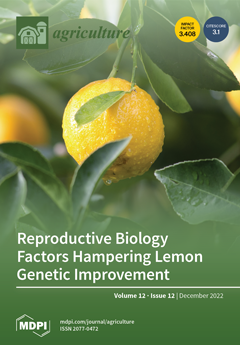Piercing–sucking insects are prominent phloem-feeding insect pests and understanding their feeding behavior and life characteristics plays a crucial role in studying insect host adaptability. The green peach aphid,
Myzus persicae (Hemiptera: Aphididae), is one of the most prominent pests in tobacco-growing areas around
[...] Read more.
Piercing–sucking insects are prominent phloem-feeding insect pests and understanding their feeding behavior and life characteristics plays a crucial role in studying insect host adaptability. The green peach aphid,
Myzus persicae (Hemiptera: Aphididae), is one of the most prominent pests in tobacco-growing areas around the world. This study evaluated the adaptability of
M. persicae to five host plants: tobacco, radish, Chinese cabbage,
Brassica oleracea, and rape using the electropenetrography, age-stage, two-sex life table and population dynamics. The results demonstrated that the feeding behavior of
M. persicae differed significantly according to the target hosts.
M. persicae exhibited reduced pathway activities and increased phloem sap ingestion on radish, whereas the opposite was observed on Chinese cabbage. Additionally, the mechanical difficulties of
M. persicae mouthparts in the probe pathway phase were significantly lower on tobacco and radish than on other host plants. Life table parameters indicated that for
M. persicae reared on radish, preadult duration, longevity, and total preoviposition increased significantly and the fecundity was the highest. Furthermore, the net reproductive rate (
R0) increased significantly. The population number of
M. persicae on radish after 15 days was significantly higher than that on other hosts, except for tobacco. Although
M. persicae can successfully survive on the five plants, our results demonstrated that radish is the optimal host. These results provide significant information for understanding the population dynamics of
M. persicae and on different host crops integrated management strategy.
Full article





